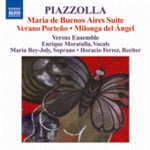
Maria de Buenos Aires Suite / Verano Porteno / Milonga del Angel
 $25.00
Out of Stock
$25.00
Out of Stock6+ weeks add to cart
PIAZZOLLA
Maria de Buenos Aires Suite / Verano Porteno / Milonga del Angel
Maria Rey-Joly (soprano) / Enrique Moratalla (vocals) / Horacio Ferrer (reciter) / Versus Ensemble
[ Naxos / CD ]
Release Date: Wednesday 12 September 2007
This item is currently out of stock. It may take 6 or more weeks to obtain from when you place your order as this is a specialist product.
The Argentinian bandoneon-player and composer Astor Piazzolla, by his creation of the 'new tango', brought the popular dance form into the concert hall.
To speak of tango is to speak of Buenos Aires. Few genres are as representative of a city as this art form, which, according to Jorge de Persia, "was nourished by the experience of musicians from Spain and Italy, as well as by those whose roots in the city by the Rio de Plata go back for generations". As a cosmopolitan metropolis with a burgeoning cultural life in which local cultural ingredients were enriched by musicians from many latitudes, the city fostered a blending of popular as well as more elite cultural elements. As a result, it is not uncommon to find musicians who performed with orchestras, chamber music ensembles and developed classical repertoire while composing and popularising tangos. In a sort of situation analogous to that of the American, George Gershwin, who combined his commitment to jazz with a desire to interweave its elements with the forms and techniques of classical music, we find the Argentinian, Astor Piazzolla, a musician who permanently straddles the divide between the popular, the classical and the traditional.
There is no doubt that this unusual composer as well as great pianist and superb bandoneon player naturally captured the essence of popular music, while exploring the forms and genres of elite musical traditions. What we cannot forget is that although his origins were steeped in the influence of Anibal Troilo, bandoneon player par excellence as well as founder of the genre, Piazzolla's subsequent contact with Nadia Boulanger in Paris and with Alberto Ginastera in Buenos Aires proved to be decisive. On his vision of tango, Piazzolla himself commented, in his compositions he tried to "bring down the final curtain on conventionalisms associated with an outdated form of tango whose time had passed forever". What we can assert at present is that Piazzolla created a unique language originating in tango, which continues to influence the most avant-garde musical trends of today. In effect, it is in that natural absorption of popular elements and their subsequent restructuring that Piazzolla gives unique lyric expression to works such as Libertango, Adios nonino and Verano Porteño.
Piazzolla achieved enormous success in a number of genres. His principal genre was chamber music. It is here where we find his most well-known works such as Estaciones Porteñas, Serie del Ángel and Todo Buenos Aires. In addition, he wrote orchestral and concertante music, for example the Concierto for Bandoneon y orquesta y Aconcagua. Regarding vocal music, we find the composer's greatest achievements in works such as Balada para un loco, Balada para mi muerte, Chiquilín de Bachín and Pajaros Perdidos. Together with poet Horacio Ferrer, Piazzolla fused chamber music with opera in María de Buenos Aires.
Certainly, it should not surprise us that that all this music is now part of modern tango, and that many of Piazzolla's works have gone on to be performed, with enormous success, at the world's greatest concert halls.
Tracks:
Milonga del Angel
Verano porteno
Chiquilin de Bachin
Libertango
Oblivion
Balada para un Loco
Maria de Buenos Aires Suite


